Key takeaways:
- Understanding and respecting fundamental sculpting techniques, materials, and proportions is crucial for success.
- Embracing mistakes as learning opportunities can foster resilience and innovation in the artistic process.
- Constructive feedback from others enhances creativity and can lead to valuable insights about one’s work.
- Documenting the sculpting journey through journaling and photography encourages self-reflection and skill development.
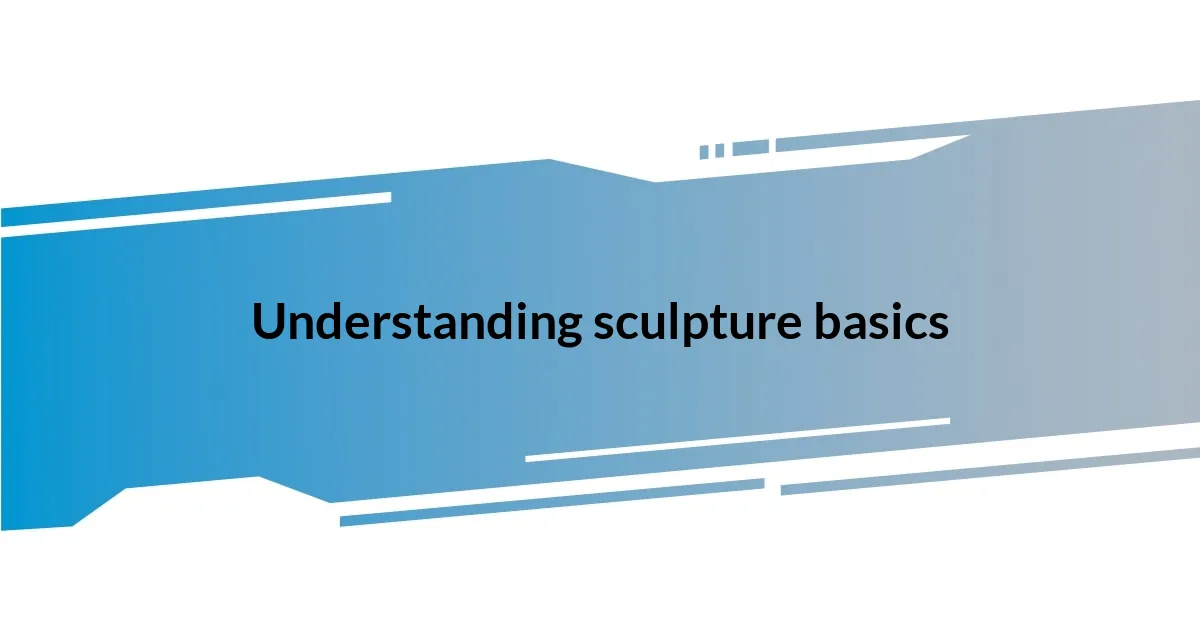
Understanding sculpture basics
Understanding sculpture basics requires a grasp of materials, form, and technique. I remember my first attempt at sculpting with clay; I was so eager that I skipped fundamental lessons. As a result, I ended up with a wobbly, misshapen creation that looked more like a blob than the figure I envisioned. Have you ever experienced that frustrating moment when your excitement overshadows the need for preparation?
The choice of material plays a crucial role in sculpture. From clay to stone, each substance brings its unique characteristics and challenges. I felt a profound appreciation for wood when I worked on my first wooden sculpture; the grain, texture, and even the scent of the material spoke to me. It’s fascinating how the right material can resonate with your artistic vision, isn’t it?
Techniques also form the backbone of sculpting. I’ve made my share of missteps, especially in understanding proportions. I once set out to create a life-sized figure but didn’t pay enough attention to anatomy, leaving me with arms that looked too long for the body. What a lesson that was! Each error taught me the importance of observation, practice, and the joy of gradual improvement in my sculpting journey.
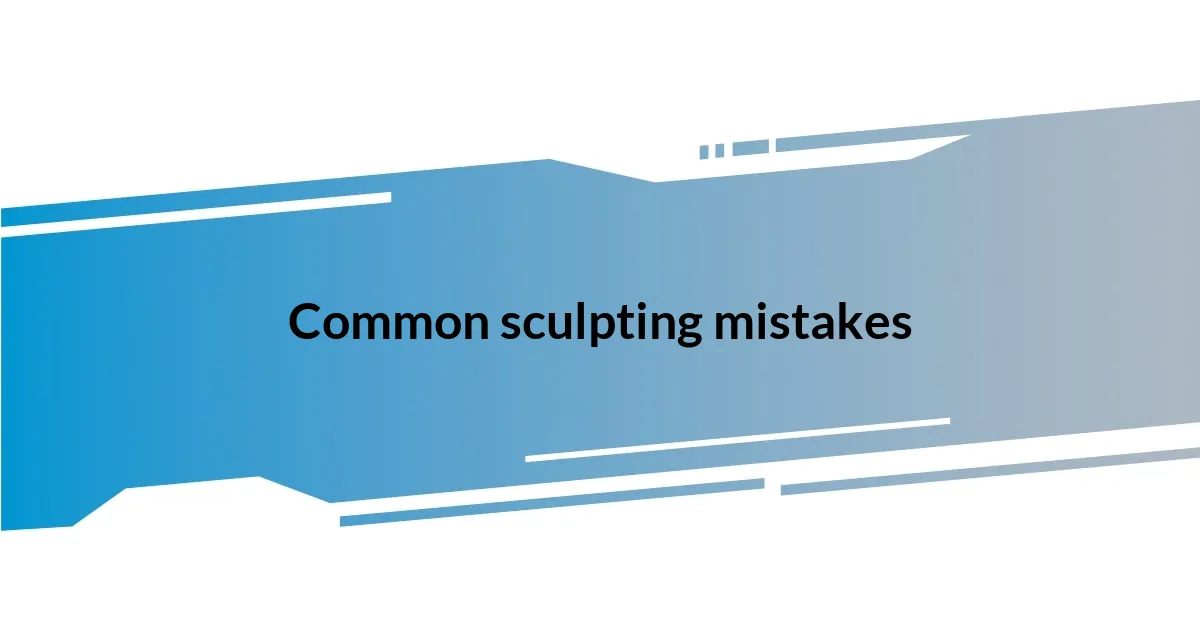
Common sculpting mistakes
One common mistake I’ve encountered in sculpting is rushing the initial stages. When you jump straight into refining details without establishing a solid base, you’ll often find the structure becoming unstable. I recall an early project where I was so eager to carve intricate patterns that I ignored the overall balance of the piece. The result? A sculpture that looked elegant from one angle but precarious from another, leading to a heart-sinking realization that I had to start over due to my haste.
Here are a few common sculpting mistakes I’ve learned from:
- Skipping essential measurements, leading to poor proportions.
- Not allowing materials enough time to dry or set, which can compromise the final piece.
- Neglecting to plan the sculpture’s layout, causing misalignment during the work.
- Overworking the details too soon, often ruining the initial form.
- Failing to consider how the sculpture will interact with light and shadow.
Seeing these errors in hindsight makes me appreciate the importance of each step. Every stumble in my journey has been a valuable reminder to respect the process.
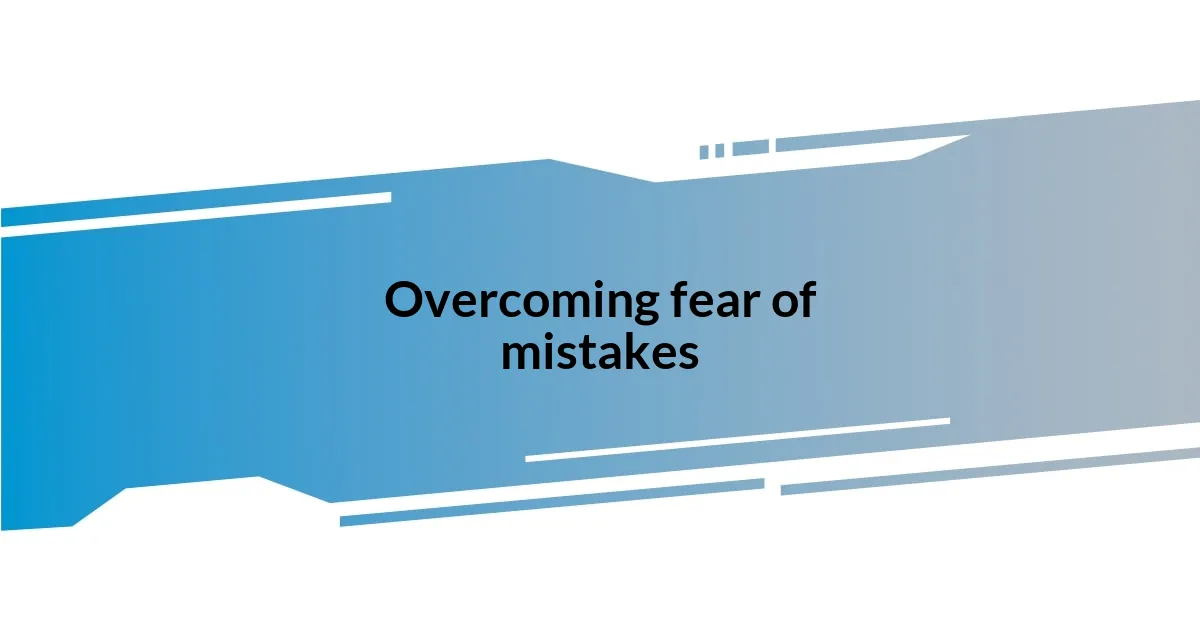
Overcoming fear of mistakes
Fear of making mistakes in sculpting can be a significant hurdle for many artists. I’ll admit, I often felt a knot in my stomach whenever I approached a new block of material. It’s like standing at the edge of a diving board, unsure whether to leap. I gradually realized that embracing those mistakes is what makes us better sculptors. Each flawed piece taught me how to adapt and innovate. Have you ever felt that fear holding you back from trying something new?
As I moved deeper into my practice, I learned to shift my perspective. Mistakes became less of a failure and more of a stepping stone. I remember one occasion when I miscalculated during a complex carving. Instead of scrapping the project, I turned the error into a new design element. That unexpected twist transformed a setback into something beautiful; it taught me resilience and the importance of viewing each misstep as an opportunity for creativity.
This mindset journey wasn’t easy; it took time to cultivate a healthy relationship with failure. I sought advice from fellow sculptors, and many shared similar stories of overcoming their fears. It was comforting to know I wasn’t alone. My ongoing experience shows that recognizing imperfections not only frees you from pressure but also opens up new realms of creativity within sculpting. What might you discover about your own artistry by embracing your mistakes?
| Mindset Shift | Emotional Journey |
|---|---|
| Embrace mistakes as learning opportunities | Moving from fear to curiosity |
| Turn errors into creative aspects of a piece | From frustration to innovation |
| Connect with other artists for support | Transform isolation into shared experience |
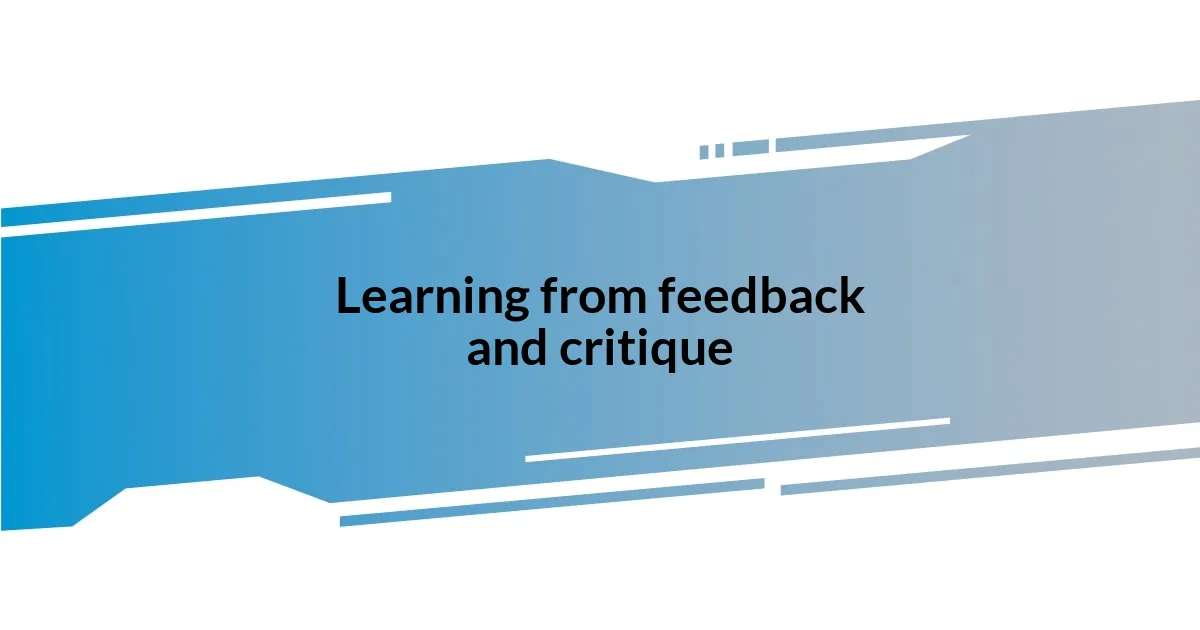
Learning from feedback and critique
When I first started sharing my work with others, the feedback often hit harder than I expected. I remember a moment when a mentor critiqued one of my pieces, and it stung. I felt defensive, but deep down, I knew their insights could help me grow. Gradually, I learned to appreciate the constructive criticism instead of viewing it as a personal attack. Have you ever found it difficult to accept feedback? I realized that each comment opened a door to new perspectives I hadn’t considered before.
Over time, I discovered that feedback isn’t just about fixing flaws; it’s a critical part of my creative process. After a particularly challenging sculpture, I invited friends to give their opinions. Their diverse viewpoints illuminated aspects of my work that I had overlooked, enhancing my understanding of how the sculpture interacted with the audience. It’s like having a fresh pair of eyes to shed light on what might be hiding in plain sight. Isn’t it fascinating how others can see what we may miss amidst our own creative bubble?
Every critique has taught me something invaluable about my work and myself. I found that embracing feedback nurtures collaboration and community among sculptors. For instance, after receiving input on a piece that felt disjointed, I went back, re-evaluated my approach, and crafted something completely different. Instead of feeling resentful, I was grateful for the chance to evolve. It’s incredible how constructive criticism can turn a lonely journey into one filled with collective growth and inspiration. What might your art look like if you invited feedback into your process?
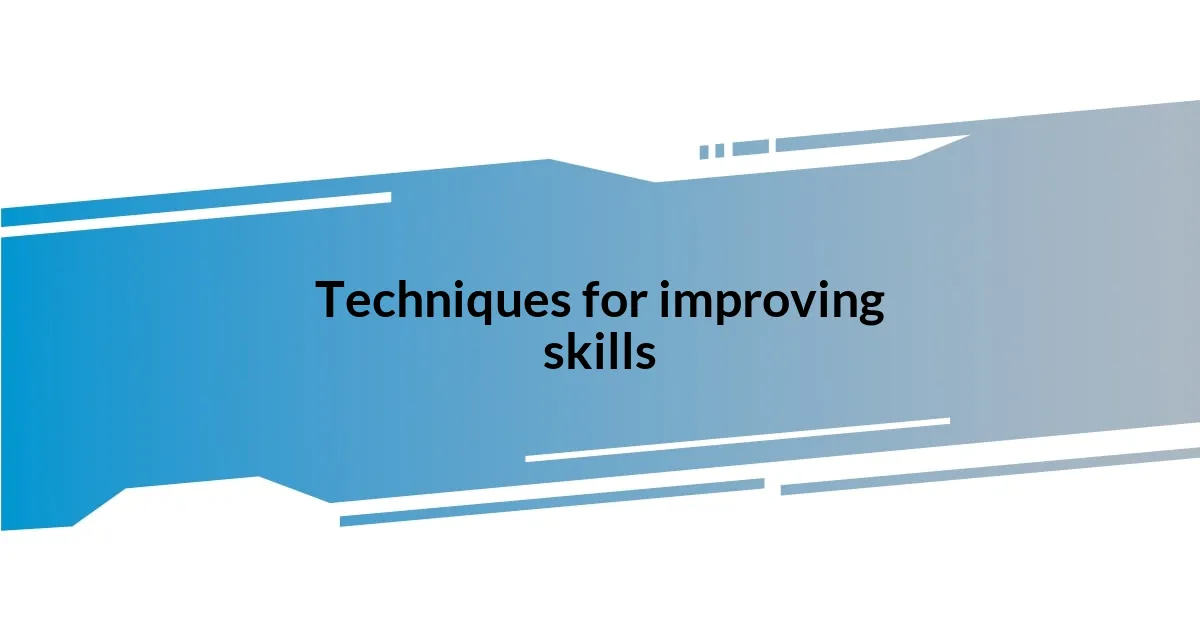
Techniques for improving skills
One technique that has genuinely helped me improve my sculpting skills is practicing with less familiar materials. After pivoting from clay to stone, I faced many challenges that forced me to adapt. At first, I was overwhelmed and frustrated by the stiffness of the medium, but I soon realized the lessons I learned from struggling with this new texture were invaluable. Have you ever explored a medium that transformed your perspective? By stepping outside my comfort zone, I found not only new ways to express myself but also renewed enthusiasm for my craft.
Another significant practice I’ve adopted is setting aside dedicated time for experimentation. I remember a period when I simply allowed myself to play without specific goals in mind. This freedom to explore led me down unexpected paths, resulting in several pieces that now hold a special place in my heart. Isn’t it liberating to create without constraints? I encourage others to carve out time for this kind of exploration, as it cultivates creativity and often leads to surprising breakthroughs.
Finally, I’ve found immense value in recording my sculpting journey. I keep a journal where I document each session’s successes and challenges. This reflection helps me identify trends—such as certain techniques that consistently yield positive results or mistakes I tend to repeat. Have you considered journaling your artistic process? It’s fascinating to see how my skills evolve over time through written reflections, and it nurtures a deeper understanding of my creative progression.
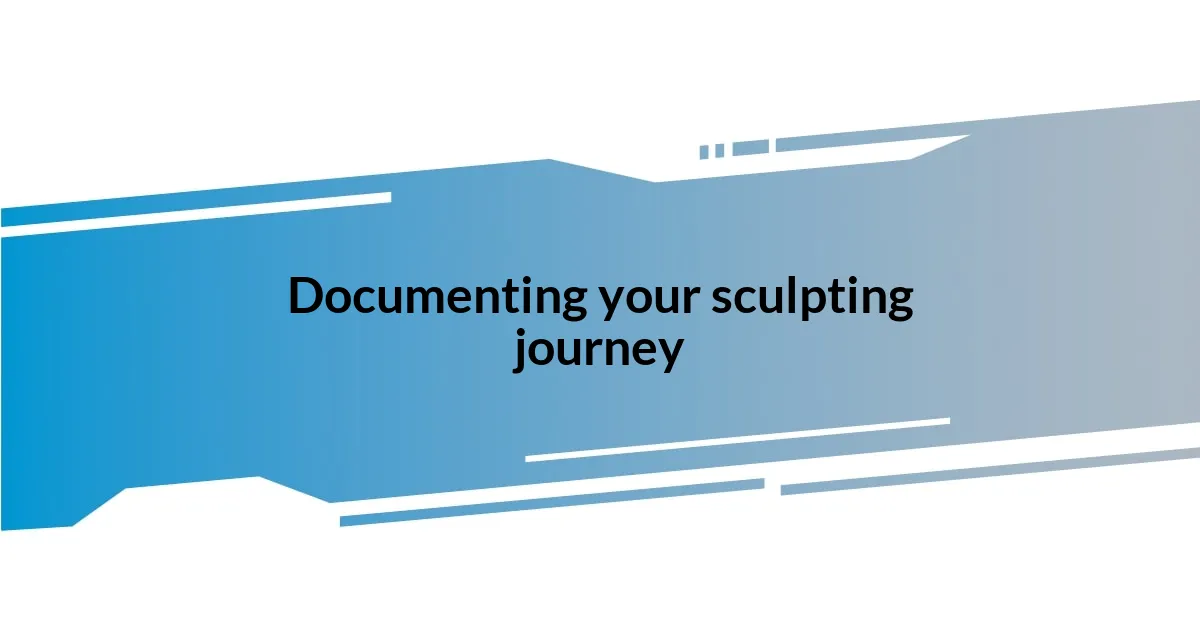
Documenting your sculpting journey
Documenting my sculpting journey has been a transformative experience. I remember starting my first art journal and feeling a rush of vulnerability. I jotted down everything—my struggles, breakthroughs, and even my frustrations. It’s like having a conversation with my past self, allowing me to reflect on where I started and how far I’ve come. Have you ever tried keeping a record of your creative process? It can be a powerful tool for self-exploration.
As I flipped through the pages, I often discovered patterns in my work that I hadn’t noticed while absorbed in the process. For instance, I realized I frequently struggled with proportions in my sculptures. Documenting those specific challenges helped me pinpoint when I needed to slow down and focus on my techniques. I found that this self-awareness not only improved my skills but also made the act of sculpting feel more intentional. Isn’t it remarkable how reflecting on our journeys can illuminate our paths forward?
Moreover, I’ve taken to capturing my progress through photographs, which has added another layer to my documentation. Looking back at old pictures of my early work hits me with a wave of gratitude and nostalgia. Each photo tells a story—the moments of desperation when I felt a piece was beyond saving, and the triumph when it finally clicked. Observing this evolution is deeply fulfilling, and it’s a great reminder that growth often comes wrapped in a series of missteps. What stories do your past creations hold?

Embracing mistakes for growth
Embracing mistakes has been a crucial step in my sculpting journey. I vividly recall a time when a sculpture I poured my heart into cracked unexpectedly. Initially, I felt defeated, but as I examined the piece, I realized the crack created a unique narrative of its own. Have you ever found beauty in what seemed like a flaw? That moment taught me that imperfections can lead to fresh perspectives, pushing me to value the process over the end result.
Mistakes are often viewed negatively, but I’ve learned to see them as stepping stones for growth. One day, while working on a complex figure, my hands slipped and distorted the clay beyond recognition. Rather than discarding it, I decided to adapt, reshaping the piece into an entirely new vision. This unexpected twist was not just a lesson in adaptability—it became one of my favorite sculptures. How often do we allow ourselves to pivot like this in our work?
Reflecting on these experiences deepens my appreciation for the role of mistakes in artistry. Each slip and miscalculation has shaped my style in ways I never anticipated. During a recent workshop, another sculptor shared their story of a piece that fell apart mid-exhibition, yet they turned that experience into an artistic installation about vulnerability. Isn’t it exciting to think about how our perceived failures can inspire others? Embracing mistakes not only fosters personal growth but also cultivates a community that celebrates resilience and creativity.